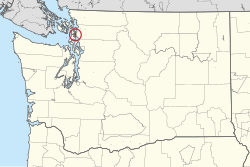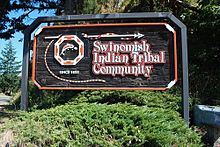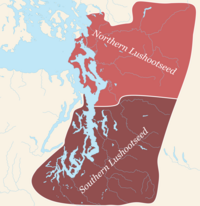Swinomish Indian Tribal Community
Swinomish Indian Tribal Community | |
|---|---|
 Location of the Swinomish Tribe | |
| Tribal headquarters | Swinomish Village |
| Largest settlement | Swinomish Village |
| Demonym(s) | Swinomish |
| Enrolled members | 1,439 |
| Government | Federally recognized tribe |
• Chair | Steve Edwards |
• Vice-chair | Jeremy Wilbur |
| Legislature | Swinomish Senate |
| Domestic dependent nation | |
• Treaty | 1855 |
• Constitution | 1936 |
The Swinomish Indian Tribal Community, also known as the Swinomish Tribe, is a federally recognized tribe located on Puget Sound in Washington state. The tribe's population includes descendants of the Swinomish, Lower Skagit, Kikiallus, and Samish peoples.
History[edit]
The origins of the Swinomish Tribe are rooted in the various aboriginal communities which make up the population of the Swinomish Tribe, including the Swinomish, Samish, Kikiallus, and Lower Skagit. The ancestral bands of the tribe originated in the Skagit and Samish river valleys and nearby coastal areas, including Fidalgo, Whidbey, Camano, and the San Juan islands.[1]
In 1855, the ancestral bands gathered at Point Elliott (Lushootseed: bək̓ʷəɬtiwʔ) along with many other tribes. They were party to the Treaty of Point Elliott.[1] Under the terms of the treaty, the Swinomish Reservation was established for the tribes in the area.[2]
Government and politics[edit]
The Swinomish Tribe and its constitution were established in 1936, following the Indian Reorganization Act, which encouraged tribes to reform their governments.
The Swinomish Tribe is governed by the Swinomish Senate, an 11 member, democratically-elected body.[1][3] Senators serve staggered five-year terms. Every year there is an election for two seats, and every five years, there is an election for five seats.[1] Each senator serves as the chair and vice-chair of at least one board or committee.[4]
The Senate governs through twenty Senate committees, as well as nine boards and commissions, established by ordinances and inter-tribal organizations. The committees do not have the authority to govern in and of themselves, but instead make recommendations to the Senate. The boards and committees operate independently from the Swinomish Tribe and Swinomish Senate.[4]
The General Council is the public body of the Swinomish Tribe's citizenry. The council is composed of all voting-age citizens. Each year, the General Council meets in Februrary to vote in the elections for the Swinomish Senate and sets the annual goals for the Swinomish Tribe.[4]
| Position | Name | Term |
|---|---|---|
| Chair | Steve Edwards | 2022-2027 |
| Vice-chair | Alana Quintasket | 2020-2025 |
| Secretary | Brian Porter | 2021-2026 |
| Treasurer | Barbara James | 2023-2028 |
| Senators | Sophie Bailey | 2020-2025 |
| Greg Edwards | 2021-2026 | |
| Tandy Wilbur | 2021-2026 | |
| Aurelia Bailey | 2022-2027 | |
| Jeremy Wilbur | 2021-2026 | |
| Bruce James Jr. | 2024-2029 | |
| Rodney John | 2024-2029 |
The Swinomish Tribe is governed by the chair of the Swinomish Senate. The chair, vice-chair, and secretary are elected by the members of the Swinomish Senate. The current chair of the Swinomish Tribe is Steve Edwards, who was elected in 2022.[1] Prior to Edwards, the Chair was Brian Cladoosby, who also served as president of the National Congress of American Indians.[5] Cladoosby succeeded Robert W. Joe in 1997.[6] Robert W. Joe was elected in 1978.[7]
| Name | Term |
|---|---|
| Robert W. Joe | 1978-1997 |
| Brian Cladoosby | 1997-? |
| Steve Edwards | 2022-2027 |
The Tribe's headquarters is in Swinomish Village.
The Swinomish Medical Center provides healthcare services for local Native Americans. Opened in 2000, the clinic building also houses a fitness center and diabetes program.[8]
Swinomish Reservation[edit]


The Swinomish Indian Reservation is the reservation and land body of the Swinomish Indian Tribal Community. The reservation is located on Puget Sound, on the southeastern side of Fidalgo Island in Skagit County, Washington.[9]
The reservation was established in 1855 by the Treaty of Point Elliot.[10] Today, the reservation is about 15 square miles (39 km2; 9,600 acres) in area,[11] however the borders of the reservation are disputed by the Swinomish Tribe. The total reservation population according to the 2000 census was 2,664. 23 percent of the population identified as being of full Native American ancestry.[citation needed]
The Seattle and Northern Railroad Company constructed a rail line over the reservation in 1889 without permission. The line is operated by BNSF Railway under a 1991 easement agreement. In 2023, BNSF spilled 3,100 gallons of diesel onto the Swinomish Reservation.[12] Prominent sites on the Swinomish Reservation include:
- Swadabs Park, on Swinomish Channel: The park features three pavilions resembling woven cedar hats, interpretive panels, and a native plant garden. The park was developed for the 2011 Canoe Journey/Paddle to Swinomish. Canoe races also take place here in the channel.
- Kukutali Preserve: the first Tribal State Park in the history of the United States to be co-owned and jointly managed by a federally recognized Native Nation and a state government. The preserve is entirely on the Swinomish Reservation and encompasses 83 acres spanning three islands, with more than two miles of natural shoreline, and is adjacent to 38 acres of Swinomish-owned tidelands.
Demographics[edit]
The Swinomish Tribe has 1,439 enrolled members according to their own figures. The majority of the population lives in the community of Swinomish Village on reservation lands. Another large percent of members reside off the reservation, in nearby Skagit County.[13]
Culture[edit]
English is commonly spoken by Tribal members. Some elders speak Swinomish (also known as Skagit), a Lushootseed language that is part of the Central Salish language family.[14] Some also spoke Samish, another Central Salish language.[15]
The Swinomish traditionally cultivated clam gardens and are reviving the practice to build climate resilience. Global warming and its effects, such as ocean acidification, affect the development of shells of marine animals vital to Swinomish food supply. As such, the Swinomish consider Indigenous health indicators a metric of climate change.[16]
Economy and services[edit]
The Swinomish Tribe owns and operates the Swinomish Casino & Lodge, overlooking Padilla Bay; Swinomish Golf Links, nearby on Highway 20; Swinomish RV Park, on Swinomish Channel; Swinomish Fish Co., which processes and cans salmon marketed worldwide under the "Native Catch" label; and two Chevron stations and convenient stores.[17]
See also[edit]
- List of Indian reservations in the United States
- List of Indian reservations in Washington
- Northwest Indian College
- Port Madison Indian Reservation
References[edit]
- ^ a b c d e "Who We Are". Swinomish Indian Tribal Community. Retrieved May 13, 2024.
- ^ "The Swinomish People". Swinomish Indian Tribal Community. Retrieved May 13, 2024.
- ^ a b "Swinomish Tribal Senate". Swinomish Indian Tribal Community. Retrieved May 14, 2024.
- ^ a b c "Government". Swinomish Indian Tribal Community. Retrieved May 14, 2024.
- ^ Kauri, Vidya (October 23, 2015). "Wash. Tribe Chairman Re-Elected As NCAI President". Law360. Retrieved February 1, 2017.
- ^ Cantwell, Brian J. (June 30, 2015). "Swinomish leader Brian Cladoosby fights for salmon and sovereignty". The Seattle Times. Retrieved February 1, 2017.
- ^ Walker, Richard (June 30, 2011). "Robert W. Joe, Former Swinomish Chairman, Passes". Indian Country Media Network. Retrieved February 1, 2017.
- ^ "Swinomish Tribe." Archived September 6, 2013, at the Wayback Machine Northwest Portland Area Indian Health Board. Retrieved September 16, 2013. A dental clinic is located nearby.
- ^ Pritzker 2001, p. 202.
- ^ Ruby, Robert H. (1992). A Guide to the Indian Tribes of the Pacific Northwest. University of Oklahoma Press. p. 231. ISBN 9780806124797.
- ^ "Swinomish Tribe". Northwest Portland Area Indian Health Board. February 9, 2016. Retrieved May 14, 2024.
- ^ Breda, Isabella (March 27, 2023). "Judge rules BNSF intentionally violated terms of easement with Swinomish tribe". The Seattle Times. Retrieved March 28, 2023.
- ^ "Community". Swinomish Indian Tribal Community. Retrieved May 13, 2024.
- ^ "Skagit." Ethnologue. Retrieved September 16, 2013.
- ^ "Salish, Straits", Ethnologue. Retrieved September 16, 2013.
- ^ Matsumoto, Kendall (February 2022). "Meeting the Challenge of Climate Change: A Makah Tribal Leader Seeks Solutions to an Ocean Out of Balance". United States National Marine Sanctuary. National Oceanic and Atmospheric Administration. Retrieved March 6, 2022.
For instance, the Swinomish Indian Tribal Community of western Washington has incorporated Indigenous health indicators into their climate change assessment process, which allows them to understand how climate-caused shellfish depletion is negatively impacting community health. Furthermore, Swinomish and First Nations of Canada are now reintroducing clam gardens, a traditional maricultural practice, which will ensure access to traditional food and harvest practices.
- ^ "Swinomish Casino & Lodge." 500 Nations. Retrieved September 16, 2013.
Bibliography[edit]
- Pritzker, Barry (2001). A Native American Encyclopedia: History, Culture, and Peoples. Oxford: Oxford University Press. ISBN 978-0-19-513877-1.
External links[edit]
- Swinomish Indian Tribal Community, official website

